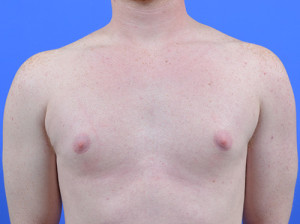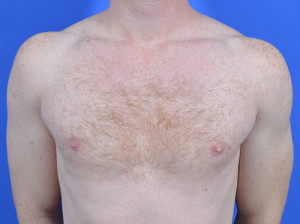Gynecomastia
Conveniently located to serve St. Louis, Missouri
Jump To:
 Gynecomastia occurs in men for a variety of reasons and can be a source of embarrassment or dissatisfaction. It can occur due to hormone intake (steroids or medications), excess alcohol or marijuana use, testicular tumors, liver dysfunction, obesity or can be idiopathic (unknown causes). Whatever the cause, the result is the formation of breast tissue below the areola. This can create a feminine shape to the breast where the nipple is “pointing” and can cause cyclical pain, or discomfort. Surgical tissue removal involving a combination of direct tissue removal, lipocontouring and fat transfers to the muscle are part of the treatment plan for optimal, natural results that will not require revision later.
Gynecomastia occurs in men for a variety of reasons and can be a source of embarrassment or dissatisfaction. It can occur due to hormone intake (steroids or medications), excess alcohol or marijuana use, testicular tumors, liver dysfunction, obesity or can be idiopathic (unknown causes). Whatever the cause, the result is the formation of breast tissue below the areola. This can create a feminine shape to the breast where the nipple is “pointing” and can cause cyclical pain, or discomfort. Surgical tissue removal involving a combination of direct tissue removal, lipocontouring and fat transfers to the muscle are part of the treatment plan for optimal, natural results that will not require revision later.
While most cases are benign, Dr. Cabbabe usually advises that you check with your medical doctor about potential causes of gynecomastia such as liver problems or hormonal imbalances prior to pursuing surgery. Alcohol and cannabis use can also contribute to this condition. If you have nipple discharge associated with a mass in your breast, you should see a breast surgeon first to rule out cancer. Appropriate blood work or imaging may need to be done to confirm there is no tumor prior to your consultation. Some men report pain in their breast that can be cyclical from the gynecomastia.
In a gynecomastia repair procedure, Dr. Cabbabe will reduce the size of your chest and reshape/sculpt the chest as needed. Tissue removal through direct excision is almost always needed, even in minor cases. Liposuction removes fat and the dense breast tissue is too large to pass through the suction cannula, the result is removal of fat only and not breast tissue which leads to a more abnormal appearance. Failure to excise the glandular breast tissue lead to recurrence, continued feminine projection and lack of muscle crease definition. Liposuction is almost always incorporated as an adjunct and additional fat transfer may be recommended into the pec muscles after the tissue has been removed, to reduce the incidence of dimples/dents/saucer deformity. It cannot be stressed enough that this is a BODY CONTOURING procedure, and the higher the BMI the more liposculpting will need to be done in order to create a flattering, contoured chest shape that blends the breast and side of the breast/chest/upper abdomen together. This will result in an increased surgical fee. IF your BMI is over 30, you will need more extensive liposuction In moderate or severe cases where the breast is large and the skin is loose, or the nipple position is low, more incisions are needed to re-shape the breast and to possibly raise a low nipple – areola to the appropriate position. A second surgery may be needed in select men with moderate droopiness that wish to avoid large scars. Dr. Cabbabe will review these techniques and options with you during your consultation.
Preparing for Surgery
Dr. Cabbabe will ask that you refrain from taking any aspirin, plavix, Coumadin, ibuprofen or any other type of blood thinner. Iron supplements are often recommended to allow faster recovery after surgery. Dr. Cabbabe strives to meet and exceed his patient’s expectations. He will meet with you and plan the best procedure based on the quality of your skin and the amount of dense breast tissue versus fatty breast tissue as well as the location of the nipple – areola.
Before & After Gallery
View before-and-after pictures of real patients of Cabbabe Plastic Surgery
Surgery
The morning of the procedure, Dr. Cabbabe will place marks on your chest where small incisions will be made to perform liposuction and around the areola where the incision will be made to remove the dense breast tissue. All of the surgical tissues are numbed up, or anesthetized, prior to surgery to minimize pain during an after surgery. High definition liposculpting of the chest and tissue removal are performed. Selective incisions are made to remove all of the fibrous, glandular breast tissue. Fat injections are done as needed into the pec muscle to minimize saucer deformities that can occur after complete gland excision. The breast fold and pec muscle are sculpted by thinning tissues in the correct areas of the breast, chest and abdomen done to smooth everything. A drain is left in place for approximately 1-2 weeks to facilitate healing.
Your Gynecomastia will be performed in a hospital or surgery center in St. Louis, MO.
Recovery
Dr. Cabbabe strives to make the procedure as easy and comfortable as possible for his patients. Before surgery, patients may receive anti-inflammatory pain medications that do not cause bleeding. At the time of surgery, local anesthesia numbing medicine is used that is long – lasting into the breast. After surgery, early range of motion is begun and pain medications are given. If this procedure is done by itself, most patients are able to go home the same day. Pain medication and antibiotics may be prescribed. There may be some numbness in the chest that will improve with time. Most patients are able to shower within 48 hours. Dr. Cabbabe will ask you to wear compression garments for up to 6 weeks after surgery to help minimize swelling and maximize your result. This is essential to an excellent result. Lymphatic massages may be recommended. Recovery is approximately 1-2 weeks from gynecomastia surgery.
Complications
Bleeding may occur after surgery and necessitate a return to the OR. This is the most frequent complication that occurs. An infection may occur and these generally require an incision and drainage procedure and do not respond to antibiotics if they occur in the first couple weeks after surgery.
Most men have asymmetry before surgery and minimal asymmetry may be present after surgery. Some of the skin may lose sensation, including potentially the nipple – areola complex. There may be areas of skin that are slow to heal, including the nipple – areola complex. Nippl-areola areas can suffer complete skin loss, this occurs more frequently in smokers due to impaired underlying blood flow. For this reason, nicotine cessation is requested. Finally, scars may become thick and irritated and require revision surgery.
Irregularities in the chest contour may be present, possibly requiring revision.


